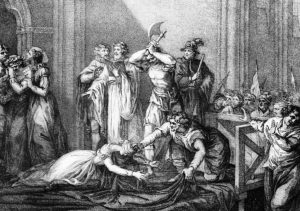Anniversary: Execution of Mary Queen of Scots
On 8th February, 1587, Mary, Queen of Scots, was executed at Fotheringay Castle in England. Her execution had been authorised by Elizabeth I of England. Mary, living under house arrest whilst in exile from Scotland, had become embroiled in plots. Too big a threat to the English crown, it was decided that there was no alternative but to see her die.
For Mary and her retinue, the order of execution came as a surprise. One French observor wrote that:
On February 7, 1587, the representatives of the English Queen, reached the Castle of Fotheringay, where the Queen of Scotland was confined at that time, between two and three o’clock in the afternoon. In the presence of her jailer, Paulet, they read their commission regarding the execution of the prisoner, and said that they would proceed with their task the next morning between seven and eight o’clock. The jailer was then ordered to have everything in readiness.
Mary, unaware that she had been judged in her absence, was sentenced to death by beheading. It was customary at the time for the condemned to be granted some rights to see people, write letters, pray as their chosen religion dictated, make their will and tidy up their affairs. Mary was denied access to her priest. Her religion, Catholicism, had been a major contributing factor in her complicity in treacherous acts.
Why did Mary, Queen of Scots have to be executed?
Read about her turbulent relationship with the English crown here.
Mary again requested her priest as she was led to the scaffold. Instead a Protestant minister was offered, which she rejected with scorn. At the scaffold Mary attempted to wear a Golden Crucifix, made from the wood of what was believed to be the True Cross. The executioner would not permit this, nor was it allowed to be passed to one of her ladies in waiting.
Mary herself was reported as being very calm at the scaffold. Indeed, it is said by witnesses that she calmed down some of her ladies who were in tears. A large audience was present. As this was the execution of a Queen, it was important to the state that many people saw the execution, so that the confirmation of it happening could be verified across the country.
Mary approached the scaffold with some assistance. She placed her own neck upon the block. It is said that her hands had to be removed from her chin as she had laid it down carefully and kept them their. Reciting a psalm in Latin, Mary reach her arms out at either side. This is a symbolic final act of defiance as it represents the sign of the cross.
The axe fell. Not once as is the ideal, but twice. Then the executioner severed the head by cutting through gristle that remained uncut. He removed her wig and held her head aloft. Mary, Queen of Scots, threat to the English crown and perpetrator of plots, was dead.
Find out more about Elizabethan England here
There are many accounts of Mary’s execution. The links below provide more detail.


